Bees pulling strings
Posted by Mad Mitch on UTC 2016-10-07 17:08
We mentioned only recently the immense growth in our understanding of the physical world around us that has taken place in the last two centuries. At all scales – from the intergalactic to the microscopic – we achieve wonders on almost a daily basis. A platitude – but we occasionally need to remind ourselves.
There are still some fields in which we have made little progress. In understanding the functioning of the human mind and memory, for example, we have barely got anywhere apart from producing competing hypotheses of gobbledygook. For example, the current fad for displaying 'functional MRI' scans of various brain 'functions' is just statistical smoke and mirrors.
Animal behaviour: inscrutable
Another field is understanding animal cognition and behaviour. Most of us listen to birdsong with a romantic pleasure that is happily not dimmed by the thought that we humans have little or no idea about what is going on in this phenomenon. The plausibility of W. S. Gilbert's explanation of the thought processes of the heartbroken dicky-bird in the song 'Tit Willow' from the Mikado is not much inferior to some current scientific speculations.
Onto our pets we project our own cultural constructs and believe we 'understand' them – and worse, that they 'understand' us. Enough of that.
Our sleep is not disturbed by the fact that we know almost nothing of the various models of the world which all animals must use in order to function. A few days ago I noticed a tiny white speck moving over a ceramic floor – too tiny to see legs or any details. I blew very gently at it from about a metre away to see how it would respond - would it react to the air current? To my surprise it was blown off course by about 10 cm, but immediately realigned itself and set off towards its original destination. Was it just moving by simple feedback sensors towards a particular light source, or being guided by an air motion or travelling along some sensory gradient such as heat or scent, or did it have some map of its environment in its minute brain? What purpose was behind its purposeful stroll? I have no idea – and I suspect no one else has, either.
The old still unanswered question presents itself: how much does the metropolitan rat 'understand' of the underground railway that is its home? Can we possibly understand what is in the rat's head? Some believe that we humans may have the same difficulty grasping our own place in the cosmic order.
Bee 'problem-solving' and 'training'
Now we have got ourselves depressed, let's look at something more cheerful in the field of animal behaviour: 'Social Learning and Cultural Transmission' in bumblebees.[1]
The research team used an apparatus that consisted of several blue disks, 'flowers', in the centre of which they placed some sucrose solution. The disks were under a clear plastic cover, which blocked access to the sucrose. The bees could smell the sucrose, but not get at it. Each disk had a short string that led out from underneath the cover. Using the strings, the disks could be dragged from under the cover, which then allowed the bees to get at the sucrose. A picture being worth a thousand words:

Three 'flower' disks containing sucrose solution, strings and perspex cover. Just need some bees, now. Images: all the images used in this article are screenshots from videos supplied by Alem et al.
Most bees did not solve the problem. We are not surprised to find that the bees were not capable of looking at the situation and working out by an operation of intellect that pulling the string would get them the sucrose. Which is actually a relief when you think about it, because if this was not the case bees would currently rule the world and keep a few humans just to sow flowers for them.
Some bees – 'innovators' – did solve the problem by sheer persistence in rapid trial and error attempts. Once the procedure of pulling the string to expose the disks had been discovered, it was 'learned': that is, the innovator bee could leave, return and carry out the procedure without needing any more trial and error. This fact on its own is a very interesting conclusion. These bees have a procedural memory. The fact that they have a memory at all is an interesting one (for me at least), that they do not live in the perpetual present in which, we are told, the goldfish swims.
We shall leave all consideration of the contribution of the 'superbee' to the well-being of the colony and all human analogies thereof to one side: 'I teach you the superbee'[2]– down that path there be many dragons and this posting is already over long.

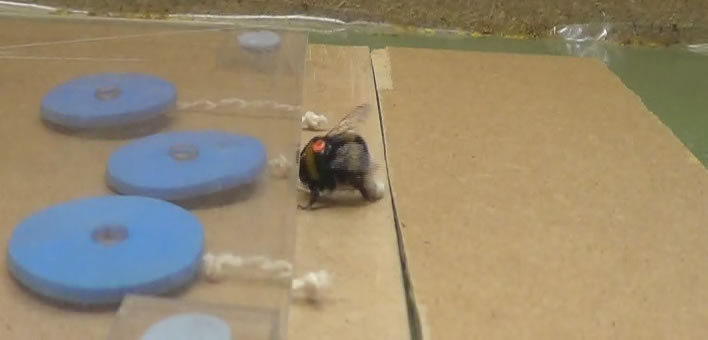
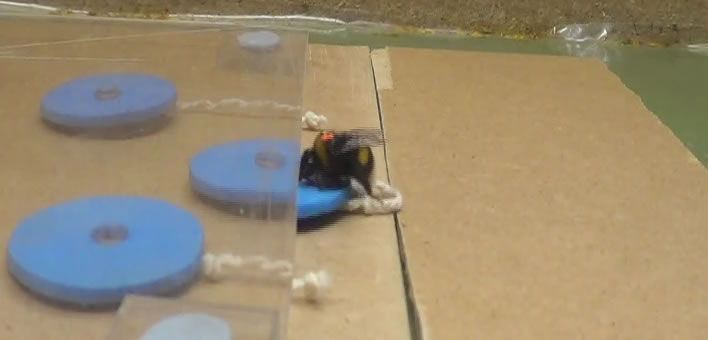
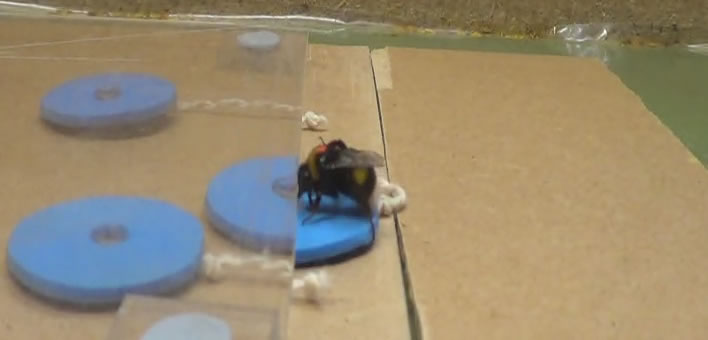
String pulling demonstrated by an expert.
Remarkable too, is the fact that bumblebees who were not innovators could be brought to learn the procedure by step-by-step training on the part of the investigators. This training involved introducing the full task in five steps by making the sucrose in the flower progressively more inaccessible, until only the option of pulling the string remained.
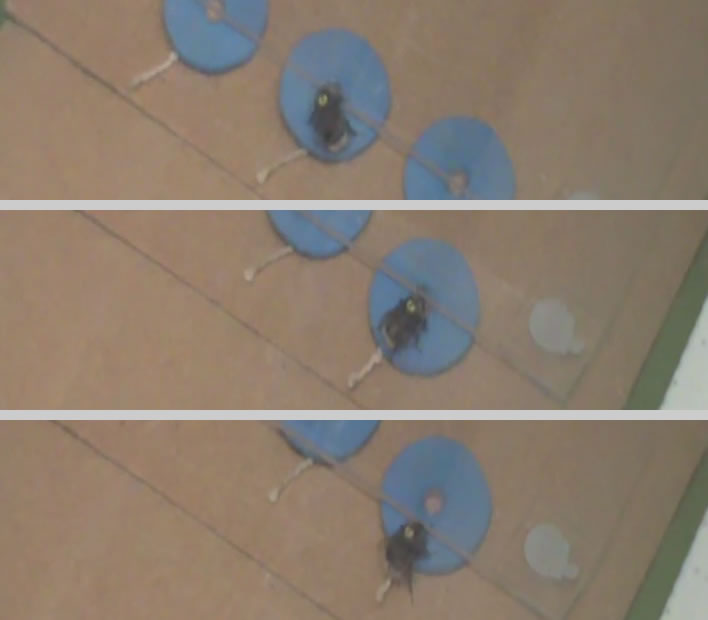
Three training steps: 1–all three flowers with accessible sucrose solution; 2–bee scrabbles the flower out; 3–bee first pulls the flower out with the string then scrabbles the flower out the rest of the way.
Even more remarkably, bumblebees could also learn the procedure by watching other bees – 'demonstrators' – doing it. If this statement were completely true we would be justified in falling off our chairs in shock. Of course, it needs some qualification: the observer bees seem to have concluded from the position of the demonstrator bee and the reward that comes to it merely that something good is going on here. The technique of pulling the string seems to have still been acquired once the bee was in the correct position by trial and error rather than copying. Pity – but still not exactly dim behaviour.
The string-pulling skill rapidly passed from the innovators to other bees, who in turn became demonstrators and in turn passed on the technique to others. The skill would be passed on through generations in the colony and outlive its original discoverer(s). Does it need to be said that the passing on of the skill was done by demonstration at the location and not by means of a chat in a quiet corner of the hive? Bees have yet to invent the flip chart.
A few very experienced string-pullers could also cope with situations in which the string had been coiled: pulling it did not at first bring the flower closer. Most bees, however, got bored and buzzed off.
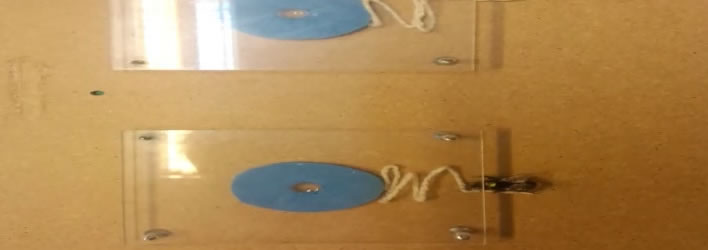
Bee pulling a coiled string.
This research opens up many further questions.
How far can experienced string-pullers adapt to changes in the configuration of the test? The colour and/or the shape of the flower, the colour and length of the string, the transparency of the cover? In other words, how situation-specific is this skill? It would be a surprise if bees all over the world started pulling on bits of string wherever they found them.
That may be unduly dismissive, because it ignores the fact that the bees involved did identify a specific situation, perhaps if only the location, in which to use this new skill. One bee did in fact pull a string that was not attached to a flower disk but which just had some sucrose on its end.
We can conclude that bees do not just accept an existing situation passively, but within the limits of their physical makeup are capable of manipulating the situation by moving, pulling etc. But we knew that already: we just need to watch them feeding from the more inaccessible flowers.
When the apparatus is taken away then we assume that the skill would disappear within one generation: no more training is going on and the knowledge of the technique would die out with the current generation. In other words: transmission depends on the existence of the problem. This case must be similar to the situation of humans before written language: knowledge of the techniques for hunting antelope would probably have disappeared quickly after the antelope themselves had gone.
References
-
^
Alem S, Perry CJ, Zhu X, Loukola OJ, Ingraham T, Søvik E, et al. (2016) 'Associative Mechanisms Allow for Social Learning and Cultural Transmission of String Pulling in an Insect'. PLoS Biol 14(10): e1002564. doi:10.1371/journal. pbio.1002564. Online, open access.
The paper includes links to a number of bee movies. The paper can be downloaded as a PDF and the movies as MP4s. Open access academic publishing: the way to go. Thank you! - ^ Friedrich Nietzsche, Also sprach Zarathustra, Teil 3, Prolog:Ich lehre euch den Übermenschen. Der Mensch ist Etwas, das überwunden werden soll. Was habt ihr gethan, ihn zu überwinden? 'I teach you the superman. Man is something to be surpassed. What have you done to surpass man?'
0 Comments UTC Loaded:
Input rules for comments: No HTML, no images. Comments can be nested to a depth of eight. Surround a long quotation with curly braces: {blockquote}. Well-formed URLs will be rendered as links automatically. Do not click on links unless you are confident that they are safe. You have been warned!